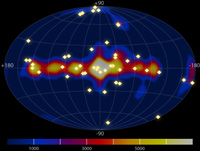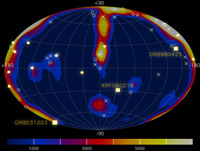INTEGRAL confirms distinct, low-luminosity population of gamma-ray bursts
13 October 2008
An analysis of the 47 gamma-ray bursts detected by INTEGRAL since its launch reveals a previously unnoticed population of faint gamma-ray bursts associated with the local supergalactic structure.This result is reported by Suzanne Foley and colleagues in the June 2008 issue of Astronomy & Astrophysics.
 |
|
Spatial distribution of 47 gamma-ray bursts detected by INTEGRAL between October 2002 to July 2007 superimposed on the exposure map for that period. (Credit: ESA) |
Gamma ray bursts (GRBs) are sudden, short (durations from milliseconds to several hundred seconds), non-repeating explosions of high-energy (from a few ten to several hundred keV) photons. They were first observed in the late 1960's by the satellites monitoring the nuclear test-ban treaty. Until the launch of the Compton Gamma Ray Observatory (1991) the observation of GRBs remained a sporadic and serendipitous event. The BATSE instrument aboard CGRO was purpose-built to monitor the whole sky for this type of event, and by the end of its 9 years of operations it had detected more than 2700 GRBs, allowing the systematic study of their characteristics to be carried out.
Global network localises and identifies GRB counterparts
The most striking piece of evidence to be derived from this first systematic catalogue of GRBs was the complete isotropy of the distribution of GRBs in the sky, suggesting a cosmological origin. Identification of possible counterparts remained however elusive, because of the large error boxes associated with the positions of the bursts. By the mid-1990's a number of models had predicted that a GRB would be followed by enhanced emission at X-ray energies (the afterglow). Then in 1997, the BeppoSAX satellite managed to detect the first X-ray afterglow of a GRB, at the same time localizing the source of the emission to about one arcminute. This allowed follow-up observations at other wavelengths to be executed. Since then the rapid location of GRB coordinates and their automatic distribution to observatories around the world has resulted in the identification of several GRB counterparts and their study at multiple wavelengths.
The most sensitive gamma-ray burst detector in space
The INTEGRAL gamma-ray observatory was designed to perform fine spectroscopy and imaging of celestial gamma-ray sources in the energy range 15 keV to 10 MeV. Although not optimized for the detection of GRBs INTEGRAL’s IBIS imaging telescope has turned out to be the most sensitive gamma-ray burst detector launched to date. This is primarily because of its very small field-of-view (when compared to the all-sky monitors more commonly used) which is very well shielded from background radiation. The combination of IBIS and the SPI spectrometer yield a valuable data set for GRBs that happen to explode in the INTEGRAL field of view.
A new population of local, low-luminosity GRBs
 |
|
The 47 INTEGRAL gamma-ray bursts plotted in supergalactic coordinates. The locations of the long-lag, low-luminosity GRBs are indicated as filled-in circles. (Credit: ESA) |
Foley and colleagues now demonstrate that INTEGRAL's high sensitivity has allowed it to detect a hitherto unnoticed population of GRBs. The team of Irish scientists analyzed the time profiles of the 47 GRBs detected by INTEGRAL in the period October 2002 to July 2007. This, together with spectral analysis, is a standard method used to categorize GRBs. In most GRBs, the higher energy emission precedes (in time) the low energy emission: this is referred to as the spectral lag. The INTEGRAL data show that events with a long (>0.75s) lag are also systematically weaker, suggesting that they belong to a different population. This conclusion is strengthened when the positions of the long-lag events are plotted in supergalactic coordinates. (The supergalactic plane is a planar structure in the local galaxy density field, mapping the distribution of galaxies in the local universe.) The events detected by Foley and colleagues appear to be aligned with the supergalactic plane, and are therefore inferred to be local and not at cosmological distances, in contrast to the distribution of high luminosity GRBs.
Within the BATSE GRB catalogue there was already some hint of a population of low-luminosity gamma-ray bursts with a tendency to concentrate near the supergalactic plane (Norris 2002). However, these appeared only at the faintest limits of the catalogue and it is only with the increased detection capability of INTEGRAL that these bursts can be clearly identified.
This result is important because it reveals another facet of the GRB phenomenology: a new population of bursts associated with sources in the local universe, a population to which the INTEGRAL telescope is particularly sensitive.
Web story author:
Giuseppe Vacanti

